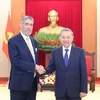Hanoi (VNA) – The upcoming visit to China of Party General Secretary Nguyen Phu Trong from January 12-15 is aimed at further strengthening the Vietnam-China ties and defining the long-term direction for the healthy and stable development of bilateral relations future.
The visit, to be made at the invitation of Party General Secretary and President of China Xi Jinping, is hoped to create strong changes and improve the efficiency of bilateral cooperation in all fields, especially in economic links, thus bringing practical benefits to both nations’ development.
Stable trend in bilateral relations
The visit takes place at a time when the overall Vietnam-China ties are stable with certain progress made in several fields.
The two nations maintained high-level visits and meetings in various forms, contributing to enhancing political trust and promoting cooperation.
It is noteworthy that leaders of the two Parties and States reached common perceptions and consensus on promoting the bilateral ties during the official visit to China made by Party General Secretary Nguyen Phu Trong in April 2015 and the State-level visit to Vietnam made by Chinese Party General Secretary and President Xi Jinping in November 2015.
The two parties have also expanded their exchange activities such as exchange of high-level visits and organisation of annual theoretical conferences and personnel training courses. They signed a cooperation agreement between the two parties and a training cooperation agreement for the 2016-2020 period.
The two countries are stepping up the implementation of their Action Plan for Comprehensive Strategic Cooperation Partnership, including the establishment of working groups on cooperation in infrastructure, cooperation for mutual development at sea, and finance – monetary.
The Steering Committee for Vietnam-China Cooperation, which was set up in November 2006, has so far convened nine sessions.
Ties between key ministries and sectors of the two countries recorded positive development. A hotline between the two Ministries of Defence was established, while regular joint activities have been held by the two border forces and coast guards. Naval ships of the two countries have also made mutual visits.
The two countries are working together in peace-keeping activities of the United Nations, as well as in fighting crimes and ensuring security and safety for agencies, enterprises and citizens of China in Vietnam and vice versa.
The Chinese side has responded positively to Vietnam’s requests of support, such as increasing the flow of water discharge from its Jinghong dam to help Vietnam overcome prolonged drought and saline intrusion in the Mekong Delta region, and in search and rescue efforts when a CASA-212 plane of the Vietnamese Coast Guard had an accident in the Bac Bo (Tonkin) Gulf.
Promoting result-oriented and effective cooperation
China has always been Vietnam’s leading trade partner while Vietnam is currently the sixth largest export market and the 11th largest import market of China.
Two-way trade reached 66.6 billion USD in 2015 and 57.6 billion USD in the first ten months of 2016, representing year-on-year increases of 13.7 percent and 5 percent, respectively.
The two countries have set the goal of 100 billion USD in two-way trade value.
In term of investment, by October 2016, China (excluding Taiwan, Hong Kong, Macau) had 1,522 investment projects worth over 10 billion USD in Vietnam, ranking ninth among 116 countries and territories investing in Vietnam. Chinese projects mainly focus on processing and manufacturing industries, electricity, gas and water. The Chinese side is seeking stronger production capacity and cross-border economic cooperation.
Since 1993, China has provided approximately 800 million USD in non-refundable aid and preferential credit capital Vietnam in more than 30 programmes.
Vietnam and China have also cooperated effectively in education, culture, sport, tourism. The two sides are implementing their cultural cooperation agreement for 2016-2018 and a deal on building cultural centres in each other’s countries.
As of April 2016, over 10,000 Vietnamese students were attending schools in China while about 4,000 Chinese students were studying in Vietnam. China also helps Vietnam in sport training.
China ranked first in the number of tourists to Vietnam. In 2015, about 1.78 million Chinese holiday-makers visited Vietnam and 2.1 million Vietnamese travelled to China. The number of Chinese arrivals in Vietnam grew 55.2 percent year on year in the first 10 months of 2016 to more than 2.2 million. Many direct air services have been opened between the two countries.
People-to-people exchange and cooperation between localities of the two nations are booming, contributing to enhancing mutual understanding between the two peoples. A total of 16 Vietnam-Chine youth friendship meetings have been arranged so far.
Orientation for healthy long-term development of ties
The two sides held the sixth session of the Vietnam-China Land Border Joint Committee in January 2016 and a conference in May the same year to review the five-year implementation of the protocol on border demarcation and marker planting, the agreement on border management regulations, and the agreement on border gates and land border gate management regulations.
They also organised the 12th joint fishery patrol in the Tonkin Gulf in November last year.
Regarding the East Sea issue, high-ranking officials of the two parties and countries have held many discussions and reached important common perception on the resolution of differences and disputes in the East Sea on the basis of respect for legitimate interest of each other and in line with international law.
The two sides agreed to well implement common perceptions and agreements reached by high-ranking leaders of the two countries, especially the “Vietnam-China agreement on basic principles guiding the settlement of sea issues”, and use effectively the Government-level negotiation mechanism on border and territory between the two nations.
They also consented to pursue friendship talks and negotiations seek long-term fundamental solutions acceptable for both sides, while well controlling disputes at sea, avoiding actions that further complicate or extend disputes, fully and effectively implementing the Declaration on the Conduct of Parties on the East Sea, working towards an early completion of a Code of Conduct in the East Sea (COC), and settling disputes by peaceful measures in line with the 1982 United Nations Convention on the Law of the Sea (UNCLOS).
The two countries completed a joint field survey in the waters beyond the mouth of the Tonkin Gulf in April 2016, and conducted the 9th negotiation of the working group on cooperation in less sensitive marine issues in China in November last year.-VNA
VNA
























